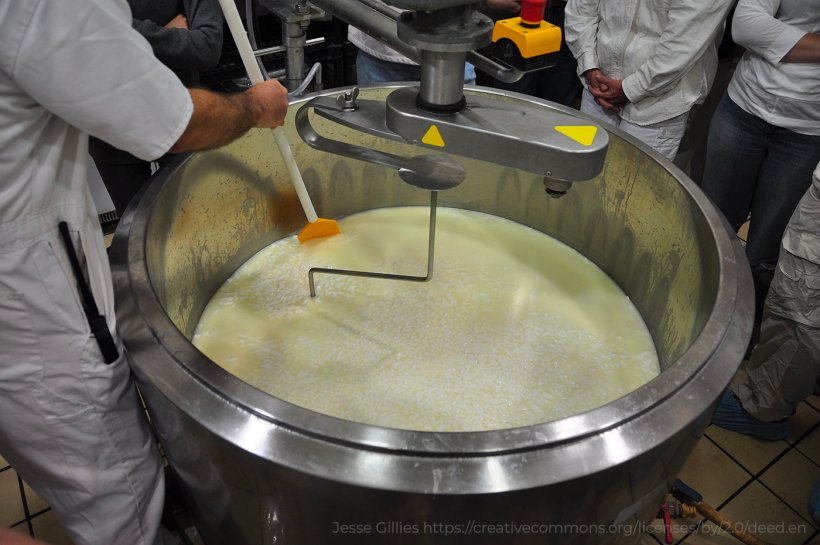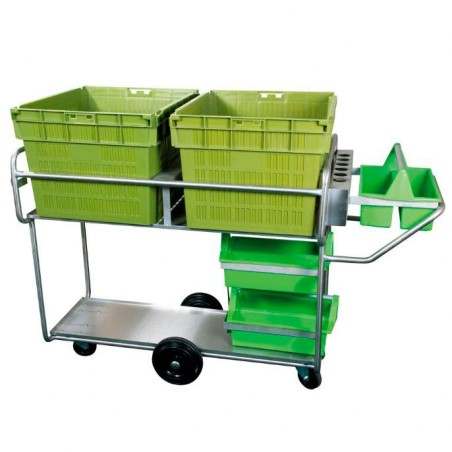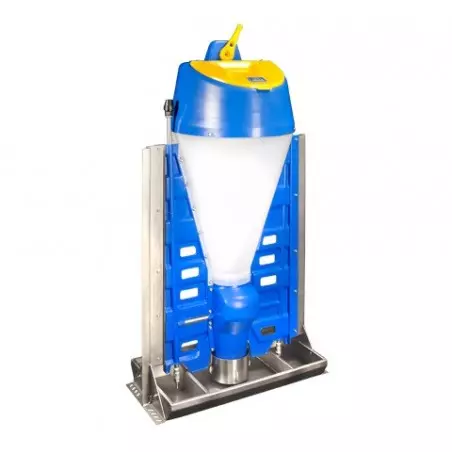Introduction
Sweet whey is a by-product resulting during the manufacture of rennet types of hard cheese, most commonly made from cattle. Its dry matter content is high at around 97%. Most of the fat and casein have been removed during the cheese-making process and subsequent filtering, but it is high in lactose (>70%) and minerals (calcium, phosphorus, potassium, and sodium). Sweet whey (11-12% protein) is a white to slightly yellow powder with a slightly sweet taste. To obtain sweet whey, after draining the cheese curd the whey needs to be processed quickly, as its temperature and composition promote the growth of bacteria leading to protein degradation and lactic acid formation. The first step is to filter and remove casein so as not to interfere with the separation process of the fat fraction via different separation methods (cyclonic separation, centrifugal separators, or vibrating / rotary screens), as both are of special interest to the food industry. Immediately after the fat is separated, cooling (<5ºC) or pasteurizing is needed to prevent bacterial activity and to ensure the quality of the final product. Finally, the quality of the product is very much subject to the method used to increase the dry matter (concentration by reverse osmosis, nanofiltration, evaporation, vapor recompression, etc.) as the energy cost of these processes is high. The temperature then needs to be brought down quickly to 30-40°C with agitation to maintain a uniform distribution of the lactose crystals allowing a non-hygroscopic suspension during final drying in drum dryers (requires mixing of wheat or rye bran to avoid sticking to the drum) or by atomization (spraying of the whey).


Sweet whey can be used to replace part of the skim milk in milk replacers and young piglet diets. However, it must be taken into account that although it is an interesting ingredient both from a nutrition and palatability standpoint, certain limitations must be considered regarding the level of inclusion depending on the type of technological presentation of the final feed. Sweet whey, with its protein content, can act as a binder and lubricant, helping to bind particles together when working with meal. But at the same time, it can hinder the flow of feed in hoppers and feeders on the diets beyond the milk replacer phase. These properties can be beneficial when working with pellets to improve pellet durability and reduce the production of fines, but in excess, they can cause serious problems during the pelleting process (difficulty of passage, excess pressure and compaction), in this sense proper control of the moisture levels of the mixture is crucial to achieving optimum pellet quality. In addition, the excess heat and pressure generated during the pelletizing process, when passage is difficult, can affect the functional properties of the whey powder and the possible interactions with other ingredients. Inclusion rates can be: low (<5%), will not cause interactions or difficulties in pelleting; medium (5% - 10%), this level is the most recommended when working with micro pelleting (<2 mm) as one needs to be careful of interaction with other raw materials and avoid force during pelleting, which can damage the nutritional value of the feed (Maillard reactions); or high (10%-20%), basically recommended for milk replacers and meal presentations. Only formulas with ingredients that provide little particle compaction will allow pelleting at these inclusion levels.
Comparative study of nutritional values
The systems used in the comparison are FEDNA (Spain), CVB (Netherlands), INRA (France), NRC (USA), and ROSTAGNO (Brazil).
| FEDNA1 | CVB | INRA | NRC | BRAZIL | |
| DM (%) | 95.5 | 98.2 | 97.1 | 97.2 | 95.2 |
| Energy value (kcal/kg) | |||||
| Crude protein (%) | 12.5 | 13.0 | 10.9 | 11.6 | 12.3 |
| Ether extract (%) | 0.9 | 0.8 | 1.6 | 0.8 | 0.9 |
| Crude fiber (%) | 0.0 | 0.0 | 0.0 | 0.0 | 0.0 |
| Starch (%) | 0.0 | 0.0 | 0.0 | 0.0 | 0.0 |
| Sugars (%) | 70.3 | 70.2 | 64.3 | 72.8 | - |
| DE growth | 3470 | - | 3560 | 3494 | 3486 |
| ME growth | 3360 | - | 3450 | 3415 | 3371 |
| NE growth | 2400 | 2682 | 2770 | 2704 | 2391 |
| NE sows | 2400 | 2682 | 2750 | 2704 | 2391 |
| Protein value | |||||
| Digestibility of crude protein (%) | 90 | 90 | 95 | 99 | 92 |
| Amino acid composition (% CP) | |||||
| Lys | 7.40 | 7.50 | 7.30 | 7.62 | 7.72 |
| Met | 1.48 | 1.50 | 1.50 | 1.47 | 1.79 |
| Met + Cys | 3.43 | 3.40 | 3.20 | 3.72 | 3.58 |
| Thr | 5.80 | 5.40 | 5.20 | 6.15 | 5.85 |
| Trp | 1.41 | 1.40 | 1.30 | 1.73 | 1.54 |
| Ile | 6.26 | 5.10 | 5.10 | 5.54 | 5.37 |
| Val | 5.06 | 4.90 | 4.70 | 5.28 | 5.28 |
| Arg | 2.15 | 2.40 | 2.10 | 2.25 | 2.85 |
| Standard ileal digestibility (% CP) | |||||
| Lys | 90 | 92 | 89 | 97 | 77.1 |
| Met | 89 | 92 | 92 | 98 | 74.3 |
| Met + Cys | 88 | 92 | 90 | 95.5 | 64.4 |
| Thr | 85 | 90 | 85 | 89 | 67.6 |
| Trp | 86 | 88 | 87 | 97 | 73.5 |
| Ile | 87 | 90 | 88 | 96 | 76.5 |
| Val | 87 | 90 | 87 | 96 | 70.1 |
| Arg | 87 | 90 | 88 | 98 | 83.1 |
| Minerals (%) | |||||
| Ca | 0.82 | 0.54 | 1.20 | 0.62 | 0.75 |
| P | 0.69 | 0.61 | 0.84 | 0.69 | 0.68 |
| Phytate P | 0.00 | 0.00 | 0.00 | 0.00 | 0.00 |
| Available P | 0.69 | - | - | - | 0.68 |
| Digestible P | 0.62 | 0.52 | 0.76 | 0.63 | 0.61 |
| Na | 0.80 | 1.05 | 0.68 | - | 0.79 |
| Cl | 1.60 | 1.85 | 1.63 | - | 1.34 |
| K | 2.07 | 2.36 | 2.04 | 1.96 | 2.08 |
| Mg | 0.13 | 0.12 | 0.15 | 0.13 | 0.11 |
1FEDNA is the only evaluation system studied that considers ovine and bovine origins together within the category of sweet whey. However, due to the fact that the majority of production and the availability of marketed product is of bovine origin, only the bovine origin will be considered for the present comparison with the rest of the valuation systems.
Unlike other dairy derivatives (high biological value protein for piglets), whey is a common ingredient in young piglet diets although the level of inclusion is highly variable among countries and feed types for young piglets.
At a general level, the average protein value among the different selected evaluation systems is 12.8%±0.87, showing a high homogeneity (CV = 6.8 overall or <5% if INRA is not considered), which indicates that there are no major variations in the process or origin of the majority species that provide the milk. However, INRA considers a CP content 6%, 11%, 13%, and 16% points lower than NRC, BRAZIL, FEDNA, and CVB, respectively. This extreme assessment by INRA also coincides with an inversely proportional assessment for fat content, which seems inconsistent with the importance of processing to remove protein so as not to interfere with fat removal (although low, INRA presents 0.7% more fat than the average of the other evaluation systems), indicating a higher impact of processing and fat removal for FEDNA, NRC, CVB, and BRAZIL.
The range of dry matter proposed by the different evaluation systems is very stable across all systems, with very little variation among them (96.6%±1.25; CV=1.30%); however, the sugar content (mainly lactose within this category) is much more variable (69.4%±3.61; CV = 5.20%), which can also condition the formulation process or the result of the formulation.
The observed variation and response to protein content associated with whey processing and casein extraction is not consistent with amino acid (AA) content taken lysine as reference for all selected evaluation systems except INRA, where the variation between evaluation systems is <5%. However, this behavior is not the same for the branched AA (Ile and Val), where on average the content is between 2% (CVB) and 6-8% (NRC and BRAZIL) higher than INRA, with FEDNA being the exception with 13% more branched AA than INRA (although it should be noted that this behavior is proportional to that of the protein content for this evaluation system). For the rest of the AA, BRAZIL presents mean values between 5 and 8% higher than FEDNA, INRA, and NRC. INRA, according to the protein and AA levels considered, presents lower values for most AA between 2 and 5% for CVB and FEDNA, between 11 and 16% than BRAZIL and CVB, and CVB has the most extreme value with tryptophan (25% more than INRA).
The digestibility coefficient for protein and lysine ranges between 90-99%, with NRC giving a higher digestibility value for whey protein and between 77-97% for lysine digestibility, with BRAZIL having the lowest value and NRC the highest.
Due to its processing, the fat and sugar content is observed to have a greater impact than protein on the estimation of the energy value. (R2 = 0.60 and 0.30, respectively) without considering INRA, since the influence of protein content does not explain any effect on the prediction of the energy value (R2 < 0.25). This response is very clear on the estimation of the net energy (NE) value in which it can be observed that while FEDNA and BRAZIL present an average NE content associated with the level of protein, fat, and sugars (NE -195 kcal/kg lower), CVB, NRC, and INRA present an increase of 93 kcal/kg, 114 kcal/kg, and 180 kcal/kg, respectively.
It is important to note that the values for most of the minerals are very variable with CV>10%, reaching even 32% CV for calcium, which indicates that although whey is a good source of minerals, it is important to take into consideration this variability between products and evaluation systems.
Recent findings
1. Effects of dietary L-glutamine and glutamic acid combination, and whey powder on the performance and nutrient digestion in weaned piglets fed grain-based diets.
The present study aimed to evaluate the influence of including L-glutamine along with glutamic acid as a supplement in weaned piglets' diets with and without whey powder. The supplementation of L-glutamine + glutamic acid or the addition of whey powder in diets for weaned piglets provided higher feed intake, greater weight gain and improved feed conversion in the initial period (24 to 42 days age). The inclusion of whey powder affected positively the digestibility coefficients analyzed except mineral matter digestibility coefficients. Amino acid supplementation alone or associated with whey powder improves the indicators of the intestinal integrity.
2. Performance of weaned pigs fed progressive increments of whey extract powder.

Whey extract powder had the following analysis: 10.2% CP, 20.0% crude fat, 11.3% Na, and 17.5% Cl. Eighty-eight pigs (initial BW 6.4 ± 1.5 kg) were blocked by weight and sorted into 8 pens. Pens were randomly assigned to receive either the control or experimental treatment for the entire trial. Within a treatment group, 4 different diets were sequentially fed in 1-wk phases. For each phase, control diets were formulated to meet digestible Lysine:NE requirements for the average pig on-test. Experimental diets were formulated to be equivalent to the control diet while including progressive increments of WEP. The inclusion rate of WEP for the experimental group began at 2.5% for the first week and progressively increased to 5.0, 7.5, and 10.0% for the second, third, and fourth week, respectively. No performance differences resulting from dietary treatment. Over the 4-wk trial, the control group had an ADG, ADFI, and G:F of 192 ± 4 g/d, 664 ± 18 g/d, and 0.29 ± 0.1, respectively. Over the 4-wk trial the treatment group had an ADG, ADFI, and G:F of 189 ± 5 g/d, 638 ± 18 g/d, and 0.30 ± 0.1, respectively, indicating that pigs grew at the same rate regardless of dietary treatment used.
3. Energy concentration and phosphorus digestibility in whey powder, whey permeate, and low-ash whey permeate fed to weanling pigs.
Two experiments were conducted to determine DE and ME, the apparent total tract digestibility (ATTD) of P, and the standardized total tract digestibility (STTD) of P in whey powder (3,646 kcal/kg), whey permeate (3,426 kcal/kg), and low-ash whey permeate (3,657 kcal/kg) fed to weanling pigs. The concentrations of DE in whey powder and low-ash whey permeate were greater than in whey permeate (3,646 and 3,683 vs. 3,253 kcal/kg of DM). The concentrations of ME in whey powder and low-ash whey permeate were also greater than in whey permeate (3,462 and 3,593 vs. 3,081 kcal/kg of DM). The ATTD of P in whey powder and in whey permeate was greater than in low-ash whey permeate (84.3 and 86.1 vs. 55.9%), but the STTD values for P were not different among the 3 ingredients (91.2, 93.1, and 91.8% in whey powder, whey permeate, and low-ash whey permeate, respectively). In conclusion, whey permeate contains less GE, DE, and ME than whey powder and low-ash whey permeate, but all 3 ingredients have an excellent digestibility of P.
4. Effects of adding liquid lactose or molasses to pelleted swine diets on pellet quality and pig performance.
The present work studied the effects of including liquid lactose (LL) and molasses (M) in swine diets on pellet quality and pig performance. Pelleted experimental diets were fed from d 0 to 21, and a common pelleted diet fed from d 21 to 33. Dietary treatments consisted of a control diet containing 19.1% total sugars from whey powder and whey permeate and experimental diets with a percentage of whey permeate replaced by either 5% or 10% LL or 9.4% cane molasses (5 LL, 10 LL, and 9.4 M, respectively). Hot pellet temperature and production rate decreased from the control to 9.4 M treatments with 5 LL and 10 LL having intermediate effects. Pellet durability index (PDI) increased in 5 LL, 10 LL, and 9.4 M, respectively. From d 0 to 7, pigs fed the 10 LL and 9.4 M treatment had the best G:F followed by the control and 5 LL treatments. Fecal consistency scores at d 7 were also firmer in pigs fed 9.4 M compared with pigs fed the control or 5 LL treatments with pigs fed the 10 LL treatment being intermediate. Moreover by using as dietary treatment a corn-soybean meal control diet with 0%, 2.5%, 5%, and 7.5% LL added in the place of corn, PDI improved with increasing inclusion of LL. No differences in ADG, ADFI, final BW, or carcass characteristics were observed although, pigs fed diets with increasing levels of LL tended to have improved G:F.
References
FAOSTAT: http://www.fao.org/faostat/es/#data/QC
http://www.mapama.gob.es/es/agricultura/temas/producciones-agricolas/cultivos-herbaceos/cereales/
FEDNA: http://www.fundacionfedna.org/
Rostagno, H,S, 2017, TABLAS BRASILEÑAS PARA AVES Y CERDOS, Composición de Alimentos y Requerimientos Nutricionales, 4° Ed,
Sauvant D, Perez, J, y Tran G, 2004, Tablas de composición y de valor nutritivo de las materias primas destinadas a los animales de inters ganedor, INRA, https://www,indexmundi,com/agriculture/






